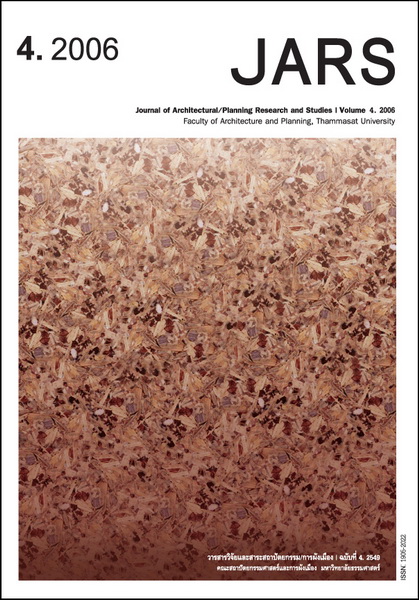Chakri Maha Prasat: A Colonial Discourse in Siamese Architecture
Main Article Content
Abstract
Modernity is a creation of the West. In a non-Western context, it normally reflects a direct intervention
of the Western powers by means of colonization. However, the Siamese, known today as the people of Thailand,
have argued that they are an exception to such an occurrence.
The shift toward Western culture and Modernity is evident in the production of Thai cultural artifacts,
notably its art and architecture throughout the 19th and 20th centuries. Many works have been the results of hybrid
designs—the syntheses between European and Siamese artistic styles, either in painting, sculpture, costume,
music, literature, performing art, cuisine, or architecture. One of the best known examples is the Chakri Maha
Prasat. Situated at the central location in the Grand Palace or Praborommaharajawung in Bangkok, this throne
hall holds more importance than simply evidence of stylistic changes; it is in essence a manifestation of social,
political, and cultural awareness, as well as bearers of national identity.
This research illustrates how various architectural ideas have contributed to the physical design and
spatial configuration of places associated with negotiation and allocation of political power in 19th century Siam,
such as the Chakri Maha Prasat. It also examines the Siamese’s resistance and reconciliation to process of
colonization.
Downloads
Article Details

This work is licensed under a Creative Commons Attribution-NonCommercial-NoDerivatives 4.0 International License.
All material is licensed under the terms of the Creative Commons Attribution 4.0 International (CC-BY-NC-ND 4.0) License, unless otherwise stated. As such, authors are free to share, copy, and redistribute the material in any medium or format. The authors must give appropriate credit, provide a link to the license, and indicate if changes were made. The authors may do so in any reasonable manner, but not in any way that suggests the licensor endorses you or your use. The authors may not use the material for commercial purposes. If the authors remix, transform, or build upon the material, they may not distribute the modified material, unless permission is obtained from JARS. Final, accepted versions of the paper may be posted on third party repositories, provided appropriate acknowledgement to the original source is clearly noted.
References
Suksri, Naengnoi. (1996). Palace Architecture in Bangkok. London: Thames and Hudson.
Tiptas, Pusadee. (1998). Chang Farang Nai Krung Siam (Western Architects in Siam). Bangkok: Chulalongkorn University.
Sukkata, Pensupa. (2000). Yeam Ruan Yeaun Ardeet [Architecture and the Past]. Bangkok: Paktas.
For Instance, see: Poshyananda, Apinan. (1992). Modern Art in Thailand: Nineteenth and Twentieth Centuries. Singapore; New York: Oxford University Press.
Aasen, Clarence. (1998). Architecture of Siam: A Cultural History Interpretation. Kuala Lumpur; New York: Oxford University Press.
Askew, Marc. (2002). Bangkok: Place, Practice and Representation, Asia’s Global Cities. London: Routledge.
Peleggi, Maurizio. (2002). Lords of Things: The Fashioning of the Siamese Monarchy’s Modern Image. Honolulu: University of Hawaii Press.
Prakitnondhakarn, Chatri. (2004). Karnmuage Lae Sungkhom in Slipasattapattayakum: Sayam Samai, Thai Prayuk, Chatniyom, Art and Culture. Bangkok: Matichon.
Markbreiter, Mark. (1994). “The Rama King and the Chakri Building,” Arts of Asia. May-June 1994.
Suksri, Naengnoi. (1996). Palace Architecture in Bangkok. London: Thames and Hudson.
Aasen, Clarence T. (1998). Architecture of Siam: A Cultural History Interpretation. Kuala Lumpur; New York: Oxford University Press.
Spivak, Gayatri Chakravorty. (1985). “The Rani of Simur” in Europe and Its Others. Vol. 1, Proceedings of the Essex Conference on the Sociology of Literature on July 1984. et al. Francis Baker. Colchester: University of Essex.
Peleggi, Maurizio. (2002). Lords of Things: The Fashioning of the Siamese Monarchy’s Modern Image. Honolulu: University of Hawaii Press.
Van Esterik, Penny. (2000). Materializing Thailand, Materializing Culture. Oxford; New York: Berg.
See: Winichakul, Thongchai. (1994). Siam Mapped: A History of the Geo-Body of a Nation. Honolulu: University of Hawaii Press.
See: Parry, Bentina. (1987). “Problems in Current Theories of Colonial Discourse.” Oxford Literary Review 9, no. 1&2.
Aasen, Clearence. (1998). Architecture of Siam: A Cultural History Interpretation. Kuala Lumpur: Oxford University
Press.
Askew, Marc. (2002). Bangkok: Place, Practice and Representation, Asia’s Global Cities. London: Routledge.
Bhabha, Homi. (1995). “Signs Taken for Wonders: Questions of Ambivalence and Authority under a Tree Outside
Delhi, May 1917.” in Europe and Its Others, Ed. by Francis Baker, 1995.
Fanon, Frantz. (1995). “On National Culture and the Pitfalls of National Consciousness.” in The Post-Colonial Studies Reader, Ed. by Bill Ashcroft, Gareth Griffiths and Helen Tiffin. London; New York: Routledge.
Fanon, Frantz. (1965). The Wretched of the Earth. New York: Grove Press.
Kalayanamitr, Choat. (1982). “Silpa-Satapattayakum Thai: Ittipol Satapattayakum Baep Tawantok [Thai Art and Architecture: Western Influence].” in Laksana Thai, Ed. by Krugrit Pramoj. Bangkok: Thai Wattanapanit.
Markbreiter, Mark. (1994). “The Rama King and the Chakri Building.” in Arts of Asia. May-June, 52-74.
Parry, Bentina. (1987). “Problems in Current Theories of Colonial Discourse.” Oxford Literary Review 9, no. 1&2, 27-58.
Peleggi, Maurizio. (2002). Lords of Things: The Fashioning of the Siamese Monarchy’s Modern Image. Honolulu: University of Hawaii Press.
Poshyananda, Apinan. (1992). Modern Art in Thailand: Nineteenth and Twentieth Centuries. Singapore; New York:
Oxford University Press.
Prakitnondhakarn, Chatri. (2004). Karnmuage Lae Sungkhom in Slipasattapattayakum: Sayam Samai, Thai Prayuk, Chatniyom. Bangkok: Matichon.
Tiptas, Pusadee. (1998). Chang Farang Nai Krung Siam [Western Architects in Siam]. Bangkok: Chulalongkorn University.
Spivak, Gayatri Chakravorty. (1985). “The Rani of Simur” in Europe and Its Others. Vol. 1, Proceedings of the Essex Conference on the Sociology of Literature on July 1984. et al. Francis Baker. Colchester: University of Essex.
Sukkata, Pensupa. (2000). Yeam Ruan Yeaun Ardeet [Architecture and the Past]. Bangkok: Paktas.
Suksri, Naengnoi. (1996). Palace Architecture in Bangkok. London: Thames and Hudson.
Van Esterik, Penny. (2000). Materializing Thailand. Oxford: Berg.
Winichakul, Thongchai. (1994). Siam Mapped: A History of the Geo-Body of a Nation. Honolulu: University of Hawaii Press.


